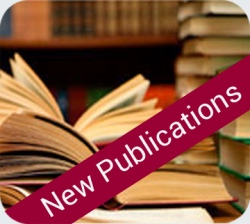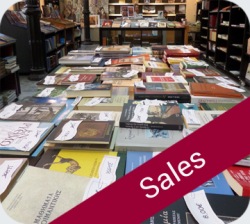May-December 2006
The judicial center of Karees existed as a place of gathering and protection for the valuable objects of which the written works in particular have a great historical value upon which the most important governing rules of the Athonite Community are laid, as well as questions regarding the arrangement and appropriate borders for the respective monasteries and their bestowed land on the peninsula and basic questions in relation to the political and ecclesiastical leaders, etc. The most important written work is the first typikon of the Holy Mountain by Emperor Ioannis Tsimiskis (972), which Saint Athanasios also signed as abbot of the Great Lavra, which he founded. It is preserved in the original form on parchment and is named “Tragos”.
The Exhibition
The largest part of the exhibit collection of icons that represent different artistic movements of the post Byzantine era. Some of these are comprised entirely of icons from the icon-screens depicting Christ and the Mother of God as they are derived from the iconostasis of the church of the Protaton. Generally the icons testify to Karees being a center of artistic production but also as a shaper of artistic tendencies, such as the famous return to the style of Panselinos which the Monk Dionysios from Fourna, in the 18th century, expressed and exemplified both as an artist and an author.
Also presented at the exhibit in their fullness and in excellent condition were iconostases, icon stands, exceptional examples of woodcarving skill icon-screens, tokens of the unceasing care of the holy community for the piety and reverence for the church of the Protaton. The variety, finally, of small works of art, which were comprised of every type of liturgical object ,which are dedications of respect to the venerable church of the Protaton, such as trays, censers, reliquaries, chalices, crosses, candles, large boxes, and icon stands etc.
In a separate group, the writings, valuable and unique, which witness to the centuries long history of Mount Athos, were presented, as well as the spiritual and cultural influence of the Athonite Monasteries in the Orthodox world.
Finally, worth mentioning are the documents of paintings and photographs in which travelers from the beginning of the seventeenth century imprinted their tokens and witnesses from the life of the holy mountain
photographs of the opening
https://www.agioritikiestia.gr/en/exhibitions/older-exhibitions/668-agion-oros-keimilia-protatou-2#sigProIdcc12e10647
The Scientific Committee
The exhibit and its parallel activities were planned and materialized under the direction and supervision of the scientific committee, which is comprised of the following members:
- Nicholas Nikonanos, Professor Emeritus of Byzantine archaeology and art history in the faculty of architecture of the polytechnic school at Aristotle University of Thessaloniki.
- Athanasios Paliouras, professor emeritus of the faculty of history and archaeology of the philosophical school of the University of Ioannina.
- Dr. Iannis Tavlakis, Director of the 10th Board of Governors of Byzantine Antiquity.
- Dr. Joachim Papaggelos, Archaeologist of the 10th Board of Governors of Byzantine Antiquity.
The thought of the scientific committee, within the framework which it conducted all its operations, as it was drawn up by the members is as follows:
The Holy Mountain-Treasures of the Protaton
An Exhibit with Unique Spiritual and Artistic Content:
It is well known that the spiritual content, the centuries long ecclesiastical heritage, the multifaceted expression of the monastic ideal, the demonstration of great ascetic heights of teachers and authors, of humble monks and saints raises, before all of us, the Holy Mountain as a world symbol of Orthodoxy and orthopraxia in the East.
Close to all of this the scientific, liturgical and artistic treasures comprise the other unique depth of educational and artistic expression of the saintly State in its 1000 year journey.
We all know as well, that the spiritual and judicial center of The Holy Mountain is Karyes. A liturgical center, landmark and monument of Karyes- and also of the entire Athonite Community- is the Church of the Protaton. Therefore, in light of the uninterrupted spiritual communication of Mount Athos with the contemporary world it was decided to transfer as many of the treasures as possible from Karyes and the Protaton to Thessaloniki, for a new approach and participation of Christians and, simultaneously, for a revival of the strong and unbreakable bonds of the greatest ascetic center of Orthodoxy with the city of Saint Dimitrios.
The Mount Athos Center, which took responsibility for the largest part of the organization of the exhibit, secured the continuous exchange of opinions, information and cooperation of the 10th Board of Governors of Byzantine Antiquity and, in a stable creative cooperation with the holy community of Mount Athos and the members of the Mount Athos representation on the judicial committee of The Mount Athos Center, were the main contributors in preparation for the exhibit.
The advice of the Christian and Byzantine Museums as well as the Benaki Museum proved valuable.
The prescriptions of a contemporary Museological-Museographical study in combination with the respect, seriousness, and sanctity that the spiritual meaning of the treasures, and the place from which they come demand, were secured with the corporation of the experienced museological team of G. Triantafillidi-D. Gourgioti, of the same team that planned and organized The Exhibit of Treasures of Mount Athos In Thessaloniki in 1997.
The advice of the experienced secretarial and communications service of the Thessaloniki branch of the organization of Transmission of Greek Culture was important.
The exhibit coincides chronologically with the renovation of the Nedelkos mansion on 109 Egnatia Street, having completed the necessary renovation into a museum it is ready to accept the collections of treasures. These are composed of the following thematic units:
A) History: Handmade iconography, handwritten codexes, various ancient writings, printed items, personalities, travelers, worship services
B) Art: Architecture (especially of the Protaton), paintings (copies of the frescoes of Manuel Panselinos), icons of the Protaton Collection from the 15th through the 19th century, miniature works of art, ecclesiastical vessels, woodcarvings, the wooden iconostasis from the chapel of the Protaton, which is found in the narthex of the Protaton.
C) Tradition-Environment: Everyday life (workshops-stores), contemporary personas of Athonite Fathers, dwelling-and multi-dwelling places, festivals and celebrations, natural environment, literary approaches.
photographs of the exhibition
https://www.agioritikiestia.gr/en/exhibitions/older-exhibitions/668-agion-oros-keimilia-protatou-2#sigProIde9405bd017
The museological-museographical team
Georgos Triantafillidis, Architectural Engineer, M.Arch. Professor Emeritus of the University of Thessalia
Dimitra Gourgioti, Architectural Engineer
The Museographical-Museological proposal for the remainder of the exhibit of the Treasures of the Protaton, as its organizers signed it is as follows:
The remainder of the exhibit of the Treasures of the Protaton in the building of the Mount Athos Center forms a realistic movement, which develops within the entire infrastructure of the building, it stays faithful to the limits and the realities of the restored building, it communicates with the new geometry that has already been installed within the framework of the building’s restructuring, into a showcase for The Holy Mountain.
On the ground level the presuppositions for an introductory meeting with The Holy Mountain are realized: they are embodied-within the boundaries of the exhibit of the treasures of the Protaton-information, photographic comments and artful processing that showcase and feature Karyes and the Protaton, its nature, constructed environment and everyday life.
- The central gallery of the exhibit maintains its basic logical designation as “transient”, it contains copies from the section of post Byzantine sculpture and simultaneously introduces, through literary texts and narratives of travelers, the theme of the exhibit which it is hosting.
- The ascent to a wooden platform welcomes one to the space of luxurious publications and other editorial and communicative reserves of the Mount Athos Center of particular artistic and pictorial interest. It is enriched with the stories and publications of travelers and writers about Karyes and the Protaton but also with photographic and sketched documents of works of preservation and restoration of the Protaton.
- The ceiling lowers in order to underscore the linear development of this section but also opens up to a monumental staircase to the internal second level, where the section on the nature and the environment of the Holy Mountain and Karyes is hosted.
- This section is developed by photographs-enlarged and engravings-old printings with clear theological references, so as to avoid the danger of a simply touristic illustration. Likewise, within the setting of the treasures of the Protaton exhibit there is a reference to the works of conservation and restoration of the church of the Protaton but also to Karyes, not only as a planned architectural unit but also to its distinguished buildings and dependencies.
On the landing to the floors the principal idea for the creation of the space capable of rendering the special qualities of a specific atmosphere. One is met firstly with the need for the impression of distinguishable rooms to disappear around one central space- exactly as it is expressed by the formal arrangement of the preserved building for which its previous purpose was clinical rooms or offices following the last restoration. If on the ground floor the first contact is made with the beauty of a fertile and robust environment, with variety and monumental staircases where all the senses participate, just as it happens on the Holy Mountain, on the first floor the viewing happens more closely, it is toward the center and it is here that the true richness is discovered and disclosed.
In the foyer of the entrance to the first hall, the pictorial rendering of the “tragos” (literally meaning ‘goat’) with the display of contemporary engravings-from the stock of the exhibit of the Treasures of Mount Athos-underscores the unique, foundational roll of the Protaton for the judicial formation of Mount Athos and meets with one of the principal narrative lines for the exhibit.
In the second hall the monumental presentation of the paintings of Panselinos illustrates an environment of copies of paintings and photographs- ready to converse with the display of portable icons and samples from contemporary works of sacred art from the workshops of the Holy Mountain. It makes a double comment above the important painting tradition of Panselinos in the way it influences the artistic product of Mount Athos until today.
In the third and fourth halls an environment of reception is created for icons from the 15th century and from the great ‘Deisis” (supplication) of the 16th century, as well as icons from the iconostasis of the Protaton. They are framed by objects from the same time period, with the intention of strengthening the internal conversations and connections and not just to demonstrate the richness of this particular collection.
The fifth hall of the “chapel” displays the illustration of icons and objects from the 17th, 18th and 19th centuries, with the presentation of the iconostasis from the small church of the Forerunner. Inside a “chapel” environment with a “salvific message”, the connection of the internal with the external world, the old with the nearly old, the present day and with the contemporary is established.
In the final hall the foundations are created for the functioning of a library, which will contain the archives, writings, and manuscripts and will mark the fundamental and emblematic character of the Protaton. The placement of a grouping of the items from the best of the exhibit of Mount Athos, the formation of a space for its reception, complete with the specific characteristics of geometry and internal sense, displays this unit in a basic core of reference for the whole of the museological-museographical narration.
Related Events
A. In the related events of the exhibit “Mount Athos-treasures of the Protaton”, A Scientific Conference with the title: ”Mount Athos: The Majesty of the Protaton. The Contribution of Karyes Across Time” took place.
B. And the catalogue of the exhibit was published containing:
The entirety of the treasures which were presented in the exhibit with the analytical headings for each one and a complete bibliography. Greetings from: His All Holiness the Ecumenical Patriarch, The Holy Community of Mount Athos, the Minister of Culture, the President of the Organization for the Dissemination of Greek Culture, the Mayor of Thessaloniki President, ex officio, of the Mount Athos Center.
Scientific texts:
- Vasilis Dimitriadis, Ottoman writings
- Ploutarchos Theocharidis, Karyes and the architecture of the Protaton
- Florin Marineskou, Romanian Writings
- Nicholaos Nikonanos, Woodcarvings
- Athanasios Paliouras, Icons
- Joachim Papagelos, Seals
- Brigitte Pitarakis and Iota Economaki-Papadopoulou, Small works of art
- Agamemnon Chelikas, Manuscripts
- Efthymios Tsigaridas, The paintings of the Protaton
- Chrisanthi Chioumbi, Manuscripts Illustrated with Icons
- Kriton Chrisochoidis, History of the Protaton and Karyes
- Kriton Chrisohoidis, Byzantine and Post-Byzantine Writings
C. A small guide for the exhibit was also published, a useful book with technical information as well as representative texts and photographs, which directs visitors of the exhibit.
D. In 2009 the publication of the proceedings from the scientific conference is expected, complete with the recommendations and the representative material (photographs, plans, etc) that will certainly comprise a scientific work of particular value, especially in the second part, dedicated to the Protaton, for which it is known lacks scientific publications.








